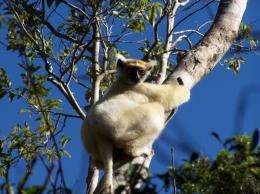New study shows pre-human effect on biodiversity in northern Madagascar

A recent study, by an international research group led by Lounes Chickhi, group leader at the Instituto Gulbenkian de Ciencia, and CNRS researcher in Toulouse, France, questions the prevailing account that degradation of tropical ecosystems is essentially a product of human activity. Their findings call for reassessment of the impact of local communities on their environment.
The impact of deforestation on loss of biodiversity is undeniable. Madagascar, a biodiversity hotspot for its richness of endemic species, has been especially hard hit by deforestation and subsequent destruction of natural habitats, caused mainly, it is thought, by human pauperisation, economic activities and population growth. A recent study, by an international research group led by Lounès Chickhi, group leader at the Instituto Gulbenkian de Ciência (Portugal) and CNRS researcher (in Toulouse, France), questions the prevailing account that degradation of tropical ecosystems is essentially a product of human activity. Their findings call for reassessment of the impact of local communities on their environment.
Published in the journal Proceedings of the Natural Academy of Sciences (PNAS)*, the research shows that the population of golden-crowned sifaka (Propithecus tattersalli), inhabitants of the Daraina region in the north of Madagascar, indeed contracted dramatically, but at a time that precedes human arrival on the island. Furthermore, by examining aerial and satellite photographs of the Daraina region, the researchers concluded that forest cover in this region has remained remarkably stable over the last 60 years, thus excluding any strong effect of humans on the environment.
Taken together, and combined with historical and paleontological records, the findings strongly suggest that the present-day open habitats of Daraina are a result of pre-human climatic changes (such as the Holocene droughts, which happened between 10 000 and 4 000 years before the present time). These may have been the cause of the increase in open landscapes in northern Madagascar, and subsequent reduction in the number of the tree-dwelling Golden crown sifakas.
The team combined genetic data, which holds specific signatures of major population contraction or expansion events, with remote-sensing data (aerial photography and satellite imao ges), to look at a long-lasting and controversial question in conservation biology: to discriminate between the contributions of human and natural factors to changes in ecosystems.
Their findings are highly relevant for the communities of climatologists, ecologists, evolutionary biologists and conservationists, as Lounès Chikhi describes, "There is no doubt that humans have played a major role in driving several Malagasy species to extinction, since their arrival on the island. Although our findings relate to a specific region in Madagascar, they shine the spotlight on how important it is that conservation projects account for regional differences. The presence of humans, we have demonstrated, may not be the only cause for loss of biodiversity. It is risky to alienate local communities by excluding them from their territories, rather that bringing them on as precious allies to help conservationists find local answers for sustainable resource management".
Lounès Chikhi points out that, despite their findings, there are not many reasons to be over-optimistic. The golden-crowned sifaka is amongst the most threatened in Madagascar – the IUCN recently proposed that it be included in their Red List as critically endangered (m.bbc.co.uk/news/science-environment-18825901). Furthermore, the Daraina region may be affected by plans to tar the main road which crosses the habitat of these lemurs, and increased poaching and mining, since the political coup in 2009, mean that conservation efforts needs to be maintained and indeed strengthened.
Provided by Instituto Gulbenkian de Ciencia


















